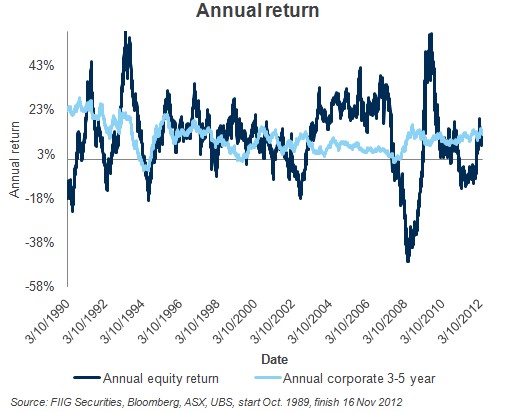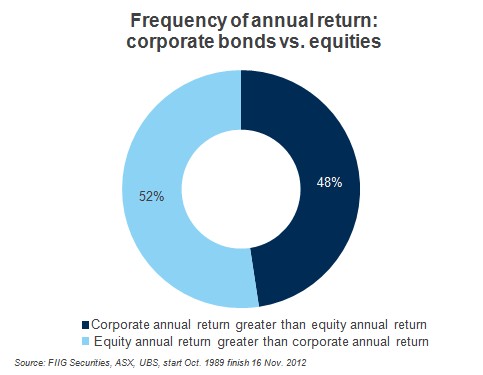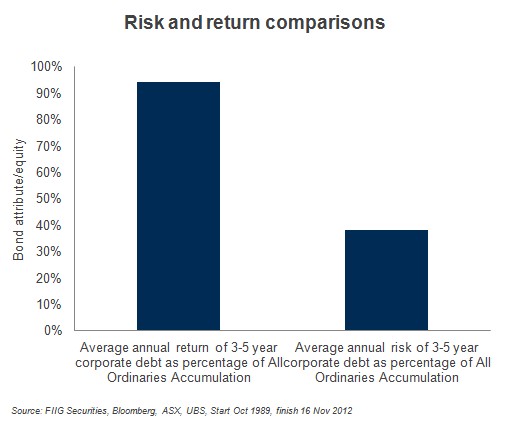by
Dr Stephen J Nash | Sep 19, 2012
Australian government bond (Australian treasury bond) yields are low and corporate bonds yields have contracted but remain attractive against government counterparts.
In this article we define the points of comparison, between debt from corporations and from the Australian government, before considering the history of the interest rate spread between these two types of debt. We then consider how often corporate credit annual returns beat Australian treasury debt and we highlight how it remains relatively cheap.
Comparison
In order to obtain a diversified and broad comparison of credit to Australian treasury bonds we use two fixed rate bond indices: the 3-5 year UBS Credit Index, and the 3-5 year UBS Treasury Index. We select the 3-5 year index, as this keeps the modified duration of both indices relatively constant, as differences in modified duration can skew the performance of an index, over diverse interest rate levels (1). By looking at the Credit Index, we look at a very broad selection of corporate bonds, which ensures that the analysis is not impacted by the fortunes of any one corporate issuer. For example, if we only looked at the Woolworths bond, then the analysis would not reflect what is happening in all other Australian credit, so that is why we refer to the Credit Index. Also, by looking at the Treasury Index, we obtain a broad range of Australian treasury bonds, so that the analysis is not impacted by the relative demand and supply, which impacts any single Australian treasury bond. Both these indices have an average yield, and by deducting the average yield on the Credit Index from the average yield on the Australian Treasury Index, we can create an interest rate spread, and this is what is we refer to as the “interest rate spread” shown in Figure 1 below (2).
History of interest rate spread
Before the global financial crisis (GFC), the interest rate spread corporations had to pay, to access debt funding was low. Essentially, before the GFC, the market was complacent about risk and was prepared to acquire corporate debt at levels that did not adequately compensate investors for the risk involved. Accordingly, the interest rate charge, or spread over the Australian Treasury Bond Index, was inadequate, meaning that access to credit was cheap for the issuer. Yet, what is cheap for the issuer, remained expensive for the investor. Things changed substantially with the GFC, investors require that corporations pay more for debt as:
- Risk of lending to corporations was brought back into focus after the Lehman collapse. Investors became generally more risk averse in the aftermath of the GFC, as evidenced in the struggle of developed world equity markets to provide adequate returns
- The possibility of an investment grade credit collapsing seemed extremely remote before the GFC but many entities with investment grade credit ratings failed during the GFC. Credit rating agencies have reassessed credit ratings, downgrading many companies and banks better reflecting the risk involved
These reasons explain why the interest rate spread, between credit and Australian treasury bonds, is now elevated, relative to historic levels as shown in Figure 1 below. Subsequent to the GFC, a compression of the spread emerged, yet that was halted by the onset of the European debt crisis, with another spread widening. Recent intervention by the ECB, through Outright Monetary Transactions (OMT) and the US Federal reserve, through additional quantitative easing, have seen a compression of spreads, yet, overall, the credit spread remains elevated, relative to historic levels.

Figure 1
While Australian treasury bond yields are low by historical standards, the reason for these low yields is important to understand, and the following points might assist:
- Australian treasury bonds reflect a global trend towards lower bonds yields, so Australia is not out of line relative to the developed world
- Developed world growth prospects are low, and are expected to remain low, especially in Europe
- Developed world inflation is expected to remain contained, given the modest outlook for growth, according to official forecasts, despite the concerns of some, regarding the recent quantitative easing in the United States
- Developed world economies are slowly reducing debt levels that accumulated before the GFC
- Developed world excess capacity is large, as expressed in the elevated levels of unemployment in most of the developed world
In other words, the overall level of Australian treasury bond interest rates are low for a reason and have nothing to do with any speculative “bubble”. Australian treasury yields just reflect the facts of life, which centre around the low prospects for growth in the developed world, as we re-build balance sheets. Expecting this situation to be quickly reversed is simply overly optimistic. In other words, the general level of interest rates, as set by Australian treasury bonds are here to stay, for the medium term, so investors need to work in those parameters and to add value, relative to the lower rates. This, apart from other things, is why we are looking at the credit market, and the story is a good one, as discussed below.
Frequency of credit beating Australian treasury bonds
Since the market charges a fee (or premium) for corporations to borrow, much like a bank charges an interest rate in order to make a profit from lending, investors typically make more money out of corporate debt, when compared to Australian treasury debt, as indicated by Figure 2 below. Figure 2 compares the annual return of both indices on a daily basis and records when the credit index beats the Australian treasury index. Credit is a solid performer, relative to treasury bonds outperforming on a daily basis 75% of the time.

Figure 2
Defining credit cheapness
Over the available history pre-GFC, we can define the average credit spread and compare the current spread to that level. Current levels are still cheap, relative to the period before the GFC, with the current spread more than three times what is was before the GFC. This fact neatly makes a mockery of the idea that “bonds” are expensive; true some “bonds” are expensive, while corporate bonds are definitely not.

Figure 3
Conclusion
When commentators talk about “bonds” being at low yields, they need to be careful about what “bonds” they are talking about. Specifically, corporate bonds are cheap, relative to historical comparison, despite the fall in Australian treasury bond yields. While current levels remain cheap on an historical basis, Figure 1 shows how we have seen a dramatic compression over the last week or so, as ECB and US federal support has bolstered equity markets. As we said last week, we believe that the current run in equity markets reflects the pricing in of QE, and that, on a medium term basis, most of the rally has already occurred. Hence investors need to take advantage of the current excitement by reducing equity holdings. When reducing equity exposures, they need to select securities that provide much better returns than cash, as well as Australian treasury bonds. While this article shows that credit remains cheap, investors would be well-advised to keep their selection of credit conservative at this time, as credit markets are joining in with the current euphoric mood in financial markets. In switching from equities, therefore, look at better quality credits first, before lower quality credits.
(1) Modified duration is a measure of the sensitivity of a bond to move movements in interest rates. Generally, the modified duration statistic tells one
(2) Data on total index return is available from 30 September 1989 until 11 September, while data on the index average yield on each index is available from 27 August 1996.